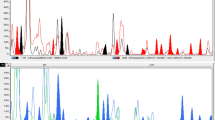Abstract
Avicennia marina is an important mangrove species with a wide geographical and climatic distribution which suggests that large amounts of genetic diversity are available for conservation and breeding programs. In this study we compare the informativeness of AFLPs and SSRs for assessing genetic diversity within and among individuals, populations and subspecies of A. marina in Australia. Our comparison utilized three SSR loci and three AFLP primer sets that were known to be polymorphic, and could be run in a single analysis on a capillary electrophoresis system, using different- colored fluorescent dyes. A total of 120 individuals representing six populations and three subspecies were sampled. At the locus level, SSRs were considerably more variable than AFLPs, with a total of 52 alleles and an average heterozygosity of 0.78. Average heterozygosity for AFLPs was 0.193, but all of the 918 bands scored were polymorphic. Thus, AFLPs were considerably more efficient at revealing polymorphic loci than SSRs despite lower average heterozygosities. SSRs detected more genetic differentiation between populations (19 vs 9%) and subspecies (35 vs 11%) than AFLPs. Principal co-ordinate analysis revealed congruent patterns of genetic relationships at the individual, population and subspecific levels for both data sets. Mantel testing confirmed congruence between AFLP and SSR genetic distances among, but not within, population comparisons, indicating that the markers were segregating independently but that evolutionary groups (populations and subspecies) were similar. Three genetic criteria of importance for defining priorities for ex situ collections or in situ conservation programs (number of alleles, number of locally common alleles and number of private alleles) were correlated between the AFLP and SSR data sets. The congruence between AFLP and SSR data sets suggest that either method, or a combination, is applicable to expanded genetic studies of mangroves. The codominant nature of SSRs makes them ideal for further population-based investigations, such as mating-system analyses, for which the dominant AFLP markers are less well suited. AFLPs may be particularly useful for monitoring propagation programs and identifying duplicates within collections, since a single PCR assay can reveal many loci at once.
Similar content being viewed by others
Author information
Authors and Affiliations
Additional information
Received: 3 October 2000 / Accepted: 19 February 2001
Rights and permissions
About this article
Cite this article
Maguire, T., Peakall, R. & Saenger, P. Comparative analysis of genetic diversity in the mangrove species Avicennia marina (Forsk.) Vierh. (Avicenniaceae) detected by AFLPs and SSRs. Theor Appl Genet 104, 388–398 (2002). https://doi.org/10.1007/s001220100724
Issue Date:
DOI: https://doi.org/10.1007/s001220100724




